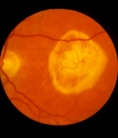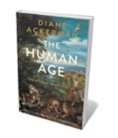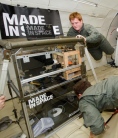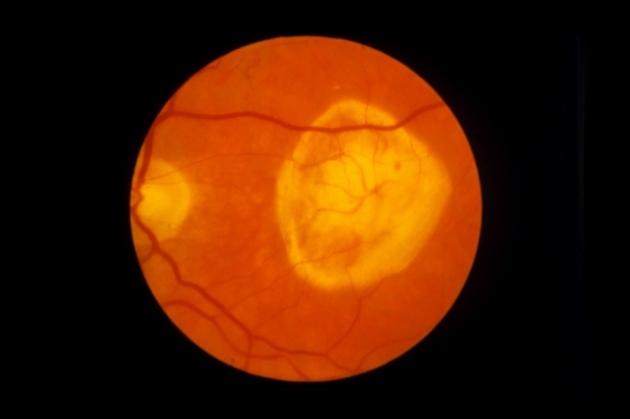
Patrice Latron/Look at Sciences/SPL
The Argus II artificial retina allows patients to distinguish light from dark, but does not yet restore full vision.
Tami Morehouse's vision was not great as a child, but as a teenager she noticed it slipping even further. The words she was trying to read began disappearing into the page and eventually everything faded to a dull, grey haze. The culprit was a form of Leber's congenital amaurosis (LCA), a group of genetic disorders in which light-sensing cells in the retina die off, usually resulting in total blindness by the time people reach their thirties or forties. But Morehouse got a reprieve. In 2009, at the age of 44, the social worker from Ashtabula, Ohio, became the oldest participant in a ground-breaking clinical trial to test a gene therapy for LCA. Now, she says, she can see her children's eyes, and the colours of the sunset seem brighter than before.
Morehouse calls these improvements life-changing, but they are minor compared with the changes in some of the younger trial participants. Corey Haas was eight years old when he was treated in 2008 — the youngest person to receive the therapy. He went from using a white cane to riding a bicycle and playing softball. Morehouse often wonders what she would be able to see now if she had been closer to Haas's age when she had the therapy. “I was born a little too soon,” she says.
Visual impairment affects some 285 million people worldwide, about 39 million of whom are considered blind, according to a 2010 estimate from the World Health Organization. Roughly 80% of visual impairment is preventable or curable, including operable conditions such as cataracts that account for much of the blindness in the developing world. But retinal-degeneration disorders — including age-related macular degeneration, the leading cause of blindness in the developed world — have no cure.
Small steps
In the past seven years, there has been mounting hope and excitement about the prospect of slowing or even reversing vision loss from retinal disorders. Clinical trials testing gene therapy, cell transplants and retinal prostheses are under way, and many studies — including the trial1, 2 involving Morehouse and Haas — are producing promising results. Biotechnology firms are taking up the challenge, and several have formed to take treatments through clinical testing. But most of the successes so far have been in treating rare congenital disorders, and it is still unclear how many people will ultimately benefit and to what extent vision can be preserved or restored. “There's a growing appreciation of the complexity of the clinical problem,” says Thomas Reh, a neurobiologist working on cell transplants for the eye at the University of Washington in Seattle.
LISTEN
Corie Lok discusses scientists’ efforts to restore sight in the blind
It may seem vulnerable and complex, but the eye has features that make it a good testing ground for experimental treatments. Unlike internal organs, surgeons can easily operate on it and peer inside to track how well a therapy is doing. It is also walled off from many damaging inflammatory responses that might derail a cell-transplant or a gene therapy. So the eye is “a good way to dip the toes in the water”, says Stephen Rose, chief research officer at the Foundation Fighting Blindness in Columbia, Maryland, which funds research and consults with drug firms.
Since 2007, clinical researchers have been dipping their toes into gene therapy for congenital forms of retinal degeneration such as LCA. The goal is to use a virus to supply retinal cells with working copies of a gene called RPE65, which is mutated in the form of the disease known as LCA2. The hope is that the working gene will repair malfunctioning cells and keep them alive, preserving and even improving vision. Trials by three different groups1, 2, 3, 4 have shown not only that the procedure is safe, but also that it boosts vision in most participants — and that most improvements seem to be maintained for up to seven years. The biotechnology company Spark Therapeutics in Philadelphia, Pennsylvania, is now testing gene therapy for LCA2 in an advanced trial, and it hopes to file for regulatory approval in the United States as early as 2016.
But some studies have raised questions about how well the therapy is working. An analysis5 of data from one4 of the three initial trials found that although participants' vision had improved, their photoreceptors were still dying at about the same rate as before the treatment. Artur Cideciyan, a vision scientist at the University of Pennsylvania in Philadelphia and a co-author of the study, says that the improvements probably came from the rescue of only some retinal cells. Gene therapy may not have affected the more dysfunctional photoreceptors, and these were the ones that probably died after treatment.
Researchers have observed that there seems to be a point of no return in some forms of retinal loss6. A possible reason is that cell death disrupts the structure of retinal tissue, leading to a domino-like decline. Cideciyan argues that after retinal degeneration has started, even cells improved by gene therapy may eventually die off, at least in LCA2.
Robin Ali, a geneticist at University College London who led one of the early LCA2 trials3, is more confident about the promise of these treatments: the careful animal work that preceded human trials showed that gene therapy, if given at the right dose and the right time, can slow degeneration. “We're still at the very start of the optimization process in humans,” he says.
Discovering the best timing for the treatment in humans remains a central challenge. Most researchers agree that the best approach is to replace the faulty gene when patients are young, before the degeneration starts or at least when there are more viable cells to save. That could mean doing retinal surgery in someone with good vision — a difficult decision, says Robert MacLaren, an ophthalmologist at the University of Oxford, UK, who is running a gene-therapy clinical trial for another form of congenital blindness7. “That is where the risks are greatest, but so are the gains.” Spark's phase III LCA2 trial was open to children as young as three years old.

Pawan Sinha
Pre- and post-operative photos of a child born blind owing to dense cataracts.
Once the damage has reached a point at which there are few or no useful photoreceptors left to save, gene therapy will probably not help. That is why some research groups are looking to other techniques, such as cell-based therapy.
Regeneration game
When people talk about the therapeutic potential of embryonic stem cells, they usually mention treatments for diabetes and spinal-cord injuries. But one of the first clinical trials for such cells was actually to treat blindness. Advanced Cell Technology in Marlborough, Massachusetts, has been conducting trials that transplant retinal pigmented epithelial (RPE) cells derived from embryonic stem cells into people with one of two forms of vision loss caused by retinal degeneration (see Nature 481, 130–133; 2012). The trials started in 2011, and researchers and industry onlookers are eagerly anticipating results later this year.
The RPE cells support the function of the photoreceptors, and the hope has been that the cell transplants will stop or slow the loss of the light sensors. Replacing photoreceptors themselves could have a higher pay-off, but deriving them efficiently from stem cells and wiring them into the retina has been difficult.
“We're still at the very start of the optimization process in humans.”
There are tantalizing signs that it could work. Ali and his colleagues, for example, have shown that when precursors to rod cells — photoreceptors that are active in dim light — are transplanted into mouse eyes, they connect with other cells in the retina and can restore vision8. They also showed that the rods can be grown from mouse embryonic stem cells and can mature and integrate into the retina9. Researchers are now working on deriving and transplanting cone cells — which enable high-acuity vision — into animals, and are starting to think about the first human trials.
Whatever the strategy, stem-cell-based treatments face some of the same issues as gene therapy: the disease processes that kill off retinal cells could continue to do so after treatment. There may be ways around this for less severe forms of blindness, says Ali, but transplanting cells into the eyes of people with very advanced disease might not work. So for these people, a more radical solution may be required.
When doctors first turned on his bionic eye, Roger Pontz thought he was dreaming: for the first time in 15 years, he could see the lights on the ceiling. The 56-year-old dishwasher from Reed City, Michigan, is one of 90 people worldwide to have received the Argus II implant, the only approved retinal prosthesis on the market. Pontz lost his sight to retinitis pigmentosa, a group of inherited disorders that cause retinal-cell death and leave most patients legally blind by the age of 40. Now, he no longer bumps into walls and he can grab the refrigerator door handle without having to feel his way towards it. “It's made life a lot better,” says Pontz.
The Argus II, made by Second Sight in Sylmar, California, was approved by the US Food and Drug Administration in 2013 for severe retinitis pigmentosa. It consists of a small camera mounted on a pair of glasses, which sends video data to a portable computer worn by the user. The processed signals are sent back through a cable to the glasses, where they are then transmitted wirelessly to a receiver wrapped around the eye. This sends the signals to a chip that has been surgically placed on top of the retina. The chip generates electrical impulses that stimulate the remaining cells of the retina.
The device — which is pricey at US$144,000 — does not restore normal vision. “We try to transform blind people into low-vision people,” says José-Alain Sahel, an ophthalmologist and head of the Institute of Vision in Paris, who was involved in testing the device in humans. Pontz says that he sees dots of light in black and white, which correspond to lines of contrast such as a doorway. With rehabilitation exercises, he is learning to make sense of those patterns (see ‘A critcial question’). He still uses a white cane and has to move his head continually up and down and side to side so that the camera in his glasses can take in the scenery.
A critical question
In the 1960s, neuroscientists showed that if one of a cat’s eyes is sutured shut early in life, then the animal will always be blind in that eye10. This led to the idea of a ‘critical period’ in visual development, a time during which visual circuitry must be used, or it will never work properly (see Nature 487, 24–26; 2012). Now, however, people who have had their vision restored are providing neuroscientists with a fresh opportunity to examine the critical period and monitor how the brain responds to visual signals that it has long been deprived of.
Leading the way is Project Prakash, an organization that has delivered vision care to more than 1,400 children in rural India since 2003. The project, headed by neuroscientist Pawan Sinha at the Massachusetts Institute of Technology in Cambridge, has given sight to more than 450 children who were born blind because of cataracts, but underwent operations to remove them when they were children or teenagers — long after the critical period for visual development was thought to have passed. Sinha and his colleagues have found11 that some aspects of the children’s vision — such as visual acuity, which is needed for reading — seem to be permanently impaired, but that others, such as the ability to tell a face from a non-face, show some level of recovery.
This shows that the critical period is not absolute, and that a person’s brain can develop significant vision even if it is first exposed to visual signals relatively late in life. “It’s not the case that they are completely compromised,” says Sinha.
Another study12 has shown how the human visual system remains resilient later in life as long as damage to the retina can be repaired. A group led by Manzar Ashtari, a brain-imaging specialist at the Children’s Hospital of Philadelphia in Pennsylvania, carried out brain-imaging studies on people whose vision had been partly restored during a gene-therapy clinical trial for a congenital form of retinal degeneration. They found that even after up to 35 years of severely impaired vision, the study participants were, surprisingly, still able to use the neural circuitry that is normally used for vision, says Ashtari. “The pathway is still intact after years of deprivation,” she says.
Recipients of treatment may require some training and therapy, but these studies are cause for optimism. If the eye can be fixed, the brain’s visual system could be malleable enough to turn light signals into useful sight.
Second Sight is now aiming to open up the technology to more people. The firm hopes to begin testing the Argus II in people with age-related macular degeneration this year. To boost the device's resolution, the company has tried squeezing more electrodes onto the chip but that did not make much of a difference. So, instead, it is focusing on improving the software, with some promising early results.
With so many advances, researchers are optimistic about the future. Even if a treatment can save or restore only a small number of light sensors in a diseased retina, that might still be enough, says Ali. “You don't need very many functioning photoreceptor cells for vision.”
It is probably not going to be perfect vision, and it may not even be a permanent fix, but as recipients such as Morehouse say, every little bit of improvement is significant.
“Even if you can give me five to ten years of vision, I'm going to take it.”
- Journal name:
- Nature
- Volume:
- 513,
- Pages:
- 160–162
- Date published:
- ()
- DOI:
- doi:10.1038/513160a





















